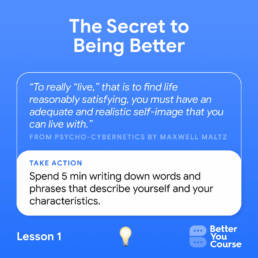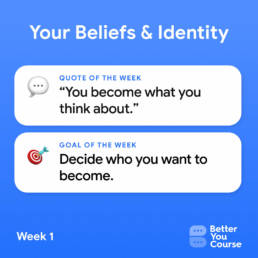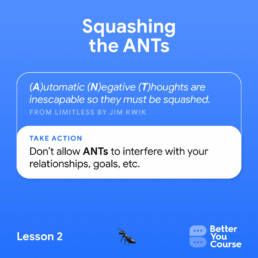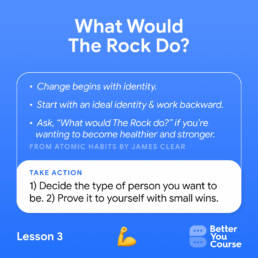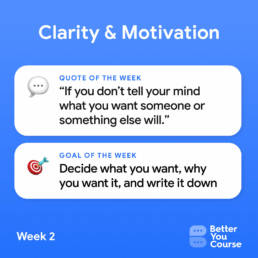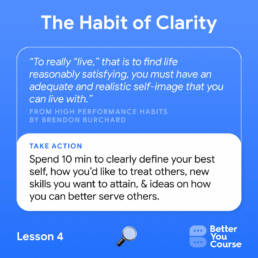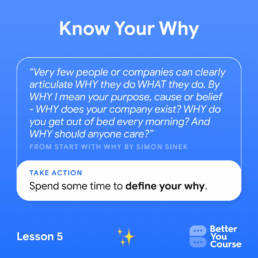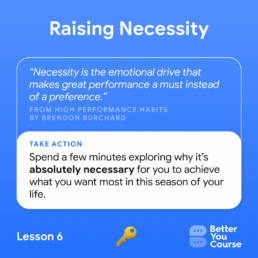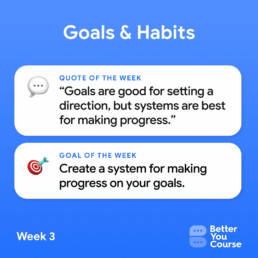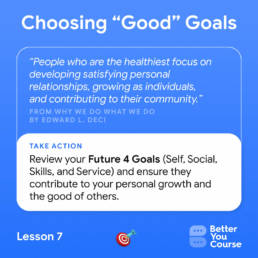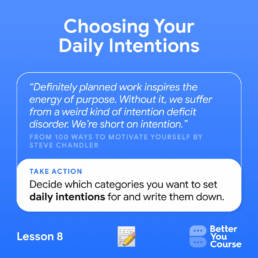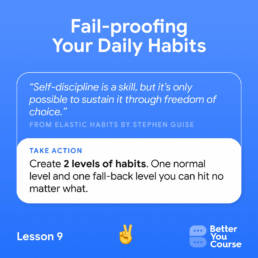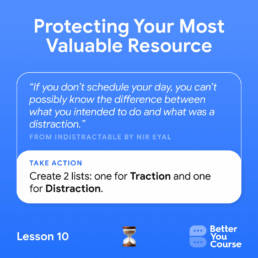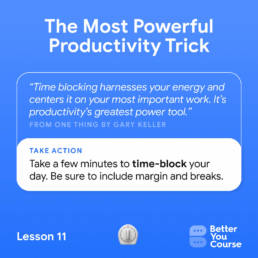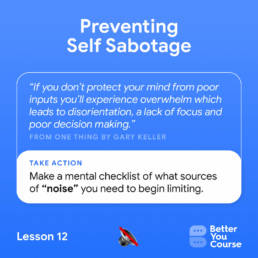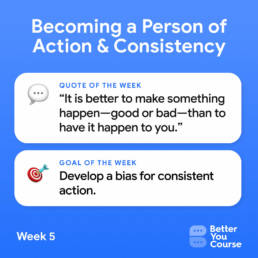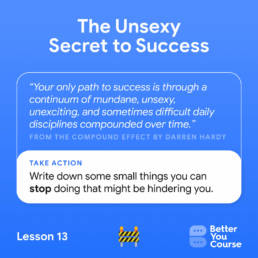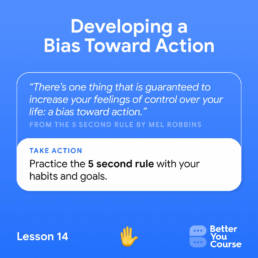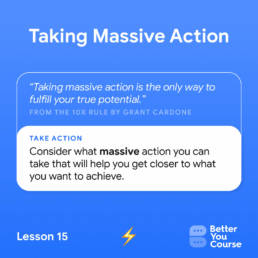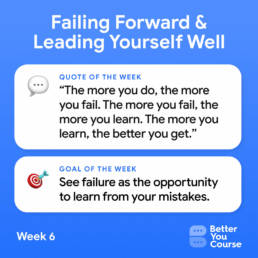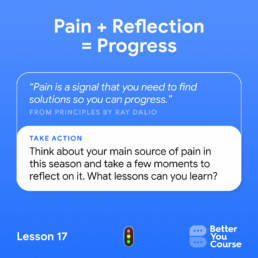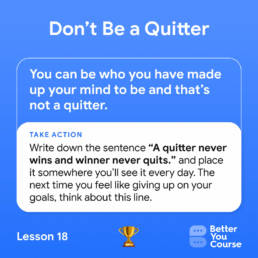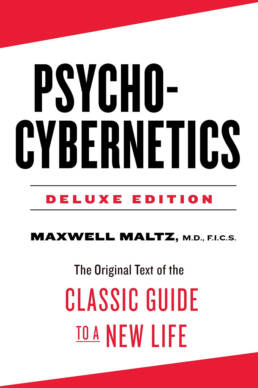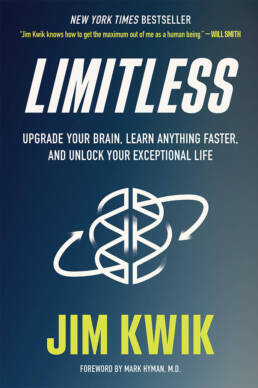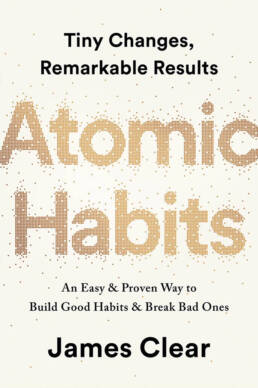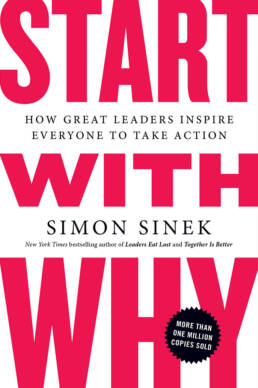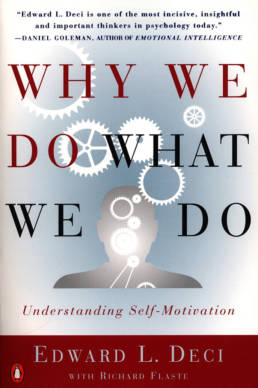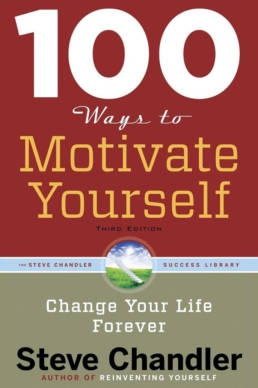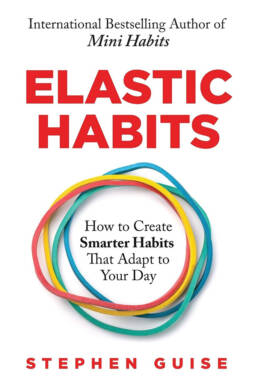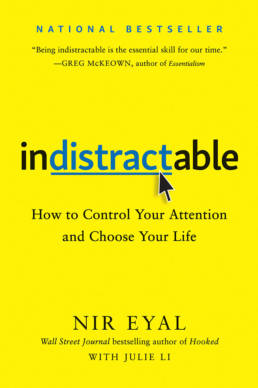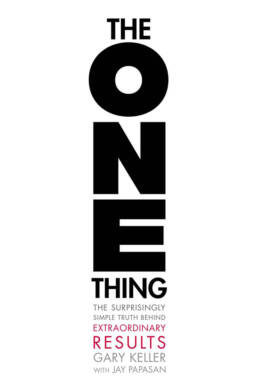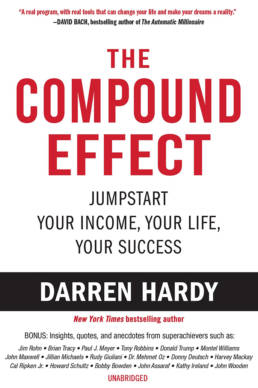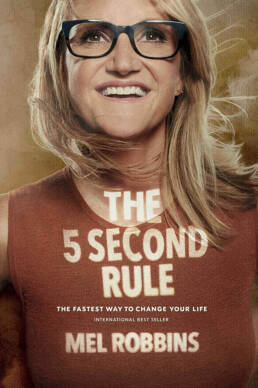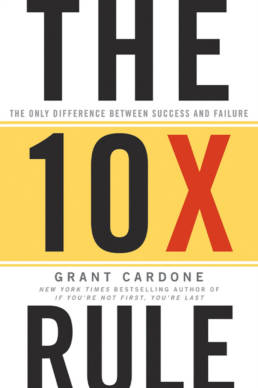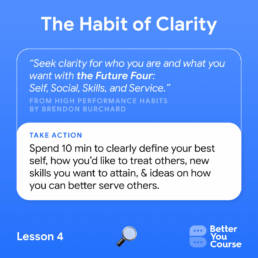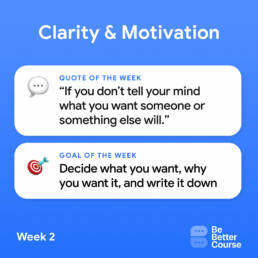The Secret to Being Better
Course 1
Better Perspective
Upgrade your mindset & boost your motivation with lessons inspired by Limitless, High Performance Habits & Start with Why.
6 VIDEO LESSONS
Lesson 1
The Secret to Being Better
Lesson 2
Squashing the ANTs
Lesson 3
What Would the Rock Do?
Lesson 4
The Habit of Clarity
Lesson 5
Know Your Why
Lesson 6
Raising Necessity
Lesson 1
The Secret to Being Better
Insight inspired by Psycho-Cybernetics (Maxwell Maltz)
Our first lesson is inspired by a book called Psycho-cybernetics by Maxwell Maltz. In his book, Dr. Maltz shares what he believes to be the secret to being better, which is simply to develop a healthy internal self-image.
During his time as a plastic surgeon, he had many patients who would have their outward appearances transformed (via surgery), but wouldn’t be happier as a result of their surgeries. In short: their outward appearance changed, but their internal feelings and attitudes towards themselves would remain the same.
Dr Maltz writes…
“To really “live,” that is to find life reasonably satisfying, you must have an adequate and realistic self-image that you can live with.”
“You must find your self acceptable to “you.” You must have a whole-some self-esteem. You must have a self that you can trust and believe in. You must have a self that you are not ashamed to “be,” and one that you can feel free to express creatively, rather than to hide or cover up. You must have a self that corresponds to reality so that you can function effectively in a real world. You must know yourself—both your strengths and your weaknesses and be honest with yourself concerning both. Your self-image must be a reasonable approximation of “you,” being neither more than you are, nor less than you are.”
Changing how you see yourself doesn’t happen overnight. That’s why our action step today is to simply write down how you see yourself. Once you have an idea of what your self-perspective is then we can start working on replacing those negative beliefs.
Action
Write It Out
Spend 5 minutes writing down words and phrases that describe yourself and your characteristics. Aim for “realness” vs. “correctness.” The reality is that the majority of these characteristics are not permanent. Some may be accurate, some may not be. The important thing is realizing that you are speaking these words over your future. Later this week we’ll decide which beliefs we’re actually going to keep and give you a hack for adopting new beliefs about yourself.
⚡️ Noise Canceling List
Action Step
Noise Canceling List
Make a mental checklist of what sources of “noise” in your life you need to begin limiting. Pick at least 3 and commit to limiting those inputs for the rest of today and note how it improves your clarity.
⚡️Time-Block Exercise
Action Step
Time-Block Exercise
Take a few minutes to time-block your day. After you’ve done this successfully for a few days, try time-blocking an entire workweek. Be sure to include margin and breaks in your time-blocking.
When you’ve completed today’s time-block exercise, share your thoughts in the community.
⚡ Create Traction Lists
Action Step
Create Traction Lists
Create 2 lists: one for Traction and one for Distraction. List all of the ways you want to gain traction daily (actions that move you toward what you want). Then, list all of the distractions you want to avoid daily. *To assist with your “Traction” list you can refer to your notes from the “Fail-Proof Your Daily Habits” micro-lesson.
⚡ Create Elastic Levels
Action Step
Create Elastic Levels
Take some time to create 2 levels of habits for each of the categories you chose in Lesson 8. One normal level and one fall-back level you can hit no matter what.
Here’s an example:

30-min Weightlifting or 25 Pushups
Complete this action?
Tap to receive a bonus article.
⚡ Choose Your Categories
Action Step
Choose Your Categories
Decide which categories you want to set daily intentions for and write them down in a notebook or notes app, then share them in the Better Community.
Here are some ideas: Spiritual/Soul Health, Exercise/Physical Health, Learning/Mental Growth, Relationships, Business/Entrepreneurship, Leadership, Financial
⚡ Make Sure Your Goals Are "Good"
Action Step
Make Sure Your Goals Are "Good"
Review your Future 4 Goals (Self, Social, Skills, and Service) and ensure they contribute to your personal growth and the good of others.
➕ Add us to your contacts
To begin receiving lessons via SMS, add us to your contacts.

Contact Card
Tyler & Emilio
“Your Growth Guides”
Complete this action?
Tap an emoji to unlock a video reward.
⚡ You need to identify your WHY
Action Step
Identify Your "Why"
Take 5 minutes to consider “What” you want to accomplish most in this season and then consider “Why” you want to accomplish it. If you don’t have a strong reason “why” you may need to re-evaluate what you’re wanting to accomplish. Share your response in the Better Community.
Better You Course
Helping Everyday People Be Better Every Day
18 micro-lessons over 6 weeks to help you upgrade your mindset, boost your motivation, develop better habits, increase your productivity, become a person of influence, and learn from failure.


Tyler & Emilio
Your Growth Guides
Course Duration
July 18th – August 29
Micro-Lessons
18 Video Micro-Lessons
Enrollments
25 Learners
Part 1: Think Better
In weeks 1 and 2, you’ll learn how to upgrade your mindset & boost your motivation with 6 lessons inspired by books like Limitless, High Performance Habits & Start with Why.
Part 2: Do Better
In weeks 3 and 4, you’ll learn how to develop better habits & increase your productivity with 6 lessons inspired by books like Why We Do What We Do, 100 Ways to Motivate Yourself & Elastic Habits.
Part 3: Lead Better
In weeks 5 and 6, you’ll learn how to become a person of influence through consistency and learning from failure with 6 lessons inspired by books like The Compound Effect, The 5 Second Rule, & Principles.
In order to effectively learn & retain the information in this course, we encourage you to follow our ABCs of Better Learning: Advice, Belief & Community.
A) Advice
Listen to the 2-minute micro-lessons on your way to work, while your coffee is brewing, or before getting out of bed.
Tip: You can access each micro-lesson in the Course Outline tab.
B) Belief
Each micro-lesson provides you an opportunity to act on what you’ve learned so you can believe it for yourself.
Tip: Download the free Course Workbook to write down your responses.
C) Community
Join the conversation in our private Better Community and connect with others about each micro-lesson.
Didn’t receive a community invite via email? Request a new invite via the blue chat bubble.
Tip: Once you’ve signed up, download the iOS app for easier access to our community!
Here’s what you can expect to receive from us each week:
Sundays at 7PM ET
You’ll receive an introduction to prepare you for the week’s micro-lessons. We’ll also layout the GOAL and QUOTE of the week.
Mondays, Wednesdays & Fridays at 7:30AM ET
You’ll receive 1 micro-lesson on each of these days.
Tuesdays & Thursdays at 7:30AM ET
You’ll receive a reminder to act on the previous day’s micro-lesson as well as an invitation to engage in a conversation in our Better Community.
Saturdays at 7:30AM ET
You’ll receive a bonus video or resource recommendation to dive deeper if you choose to.
We want to hear from you!
If you have a question, want to provide feedback or have come across a bug or error, please let us know by clicking on the blue chat bubble on the bottom right of your device. ![]()
How to Take This Course
The ABCs of Better Learning
In order to effectively learn & retain the information in this course, we encourage you to follow our ABCs of Better Learning: Advice, Belief & Community.
A) Advice
Listen to the 2-minute micro-lessons on your way to work, while your coffee is brewing, or before getting out of bed.
Tip: You can access each micro-lesson in the Course Outline tab.
B) Belief
Each micro-lesson provides you an opportunity to act on what you’ve learned so you can believe it for yourself.
Tip: Download the free Course Workbook to write down your responses.
C) Community
Join the conversation in our private Better Community and connect with others about each micro-lesson.
Didn’t receive a community invite via email? Request a new invite via the blue chat bubble.
Tip: Once you’ve signed up, download the iOS app for easier access to our community!
Weekly Learning Schedule
Here’s what you’ll receive from us each week:
Sundays at 7PM ET
You’ll receive an introduction to prepare you for the week’s micro-lessons. We’ll also layout the GOAL and QUOTE of the week.
Mondays, Wednesdays & Fridays at 7:30AM ET
You’ll receive 1 micro-lesson on each of these days.
Tuesdays & Thursdays at 7:30AM ET
You’ll receive a reminder to act on the previous day’s micro-lesson as well as an invitation to engage in a conversation in our Better Community.
Saturdays at 7:30AM ET
You’ll receive a bonus video or resource recommendation to dive deeper if you choose to.
Course Outline
Part 1: Think Better
In weeks 1 and 2, you’ll learn how to upgrade your mindset & boost your motivation with 6 lessons inspired by books like Limitless, High Performance Habits & Start with Why.
Part 2: Do Better
In weeks 3 and 4, you’ll learn how to develop better habits & increase your productivity with 6 lessons inspired by books like Why We Do What We Do, 100 Ways to Motivate Yourself & Elastic Habits.
Part 3: Lead Better
In weeks 5 and 6, you’ll learn how to become a person of influence through consistency and learning from failure with 6 lessons inspired by books like The Compound Effect, The 5 Second Rule, & Principles.
BBP - Part 3 | Lesson 18
Part 3
Lead Better
Become a person of influence through consistency and learning from failure with 6 lessons inspired by The Compound Effect, The 5 Second Rule, & Principles.
Week 5
Introduction
Lesson 13
Lesson 14
Lesson 15
Week 6
Introduction
Lesson 16
Lesson 17
Lesson 18
Don’t Be a Quitter
Lesson 18
Don’t Be a Quitter
Insight inspired by Think and Grow Rich (Napoleon Hill)
“If you give up before your goal has been reached, you are a ‘quitter.’ A quitter never wins and winner never quits. Lift this sentence out, write it on a piece of paper in letters an inch high, and place it where you will see it every night before you go to sleep, and every morning before you go to work.”
-Napoleon Hill
The message of this final micro-lesson is a simple one: DON’T BE A QUITTER. By making it to the final lesson of this course you should have all the proof you need that you’re not a quitter.
As we learned in the first part of this course, you can be who you have made up your mind to be and that’s not a quitter.
If you will revisit these micro-lessons on a regular basis, if you embrace failure as a learning experience, and you refuse to quit — I can virtually guarantee you that you will find success in whatever ways you’ve defined it.
In Part 1 you learned how to THINK BETTER… by solidifying your identity with healthy beliefs, clarifying what you want in life, and backing it up with a strong reason why it’s worth the effort.
In Part 2, you learned how to DO BETTER… by choosing good goals, setting daily intentions, fail-proofing your habits, and preventing self-sabotage.
And finally, in Part 3, you learned how to LEAD BETTER… by developing a bias for action, redefining failure, and embracing the pain of progress.
It now all comes down to your ability to stay committed and your refusal to be a quitter.
Action
Never Quit
Write down the sentence “A quitter never wins and a winner never quits.” and place it somewhere you’ll see it every day. The next time you feel like giving up on your goals, think about this line.
Community
Don't Do It Alone
Join the conversation in our private community and connect with others about each micro-lesson.
BBP - Part 3 | Lesson 17
Part 3
Lead Better
Become a person of influence through consistency and learning from failure with 6 lessons inspired by The Compound Effect, The 5 Second Rule, & Principles.
Week 5
Introduction
Lesson 13
Lesson 14
Lesson 15
Week 6
Introduction
Lesson 16
Lesson 17
Pain + Reflection = Progress
Lesson 18
Lesson 17
Pain + Reflection = Progress
Insight inspired by Principles (Ray Dalio)
Ray Dalio, the leader of Bridgewater, the largest hedge fund in the world, says:
“Pain is a signal that you need to find solutions so you can progress.”
To put it even more simply, “Pain + Reflection = Progress.”
Instinctively, we want to withdraw from pain but when we do that we miss the opportunity to reflect and learn from our mistakes. Pain + Reflection = Progress.
Most people get comfortable operating without pain. It’s easier that way. But those who succeed in life embrace the pain, learn from what went wrong, take ownership of it, and eventually see progress.
Action
Reflect & Learn
You cannot improve and be better if you do not reflect on your moments of pain. Think about your main sources of pain in this season (a difficult co-worker, a big project, feedback you’ve received, etc.) and take a few moments to reflect on it. What lessons can you learn from the pain?
Community
Don't Do It Alone
Join the conversation in our private community and connect with others about each micro-lesson.
BBP - Part 3 | Week 6
Part 3
Lead Better
Become a person of influence through consistency and learning from failure with 6 lessons inspired by The Compound Effect, The 5 Second Rule, & Principles.
Week 5
Introduction
Lesson 13
Lesson 14
Lesson 15
Week 6
Introduction
Failing Forward & Leading Yourself Well
Lesson 16
Lesson 17
Lesson 18
Week 6 Introduction
Failing Forward & Leading Yourself Well
It’s the final week of the Better You Course and we’re focusing on failing forward. Failing forward is the #1 most important skill when it comes to leading yourself well and leading others.
In life, it’s not a matter of if you will fail. It’s just a matter of when you will fail and how you will respond.
We all will fail at some point in our journey but winners and leaders dust themselves off, learn from their mistakes, and see it as an opportunity to get better. As difficult as it may be, it’s time to redefine failure and start embracing the lessons it can teach.
It took JK Rowling 7 years to write the first Harry Potter book and then all 12 major publishing houses rejected the story.
217 of 242 investors turned down Howard Schultz, the business leader who brought Starbucks to the world.
Walt Disney’s first company went bankrupt.
Oprah Winfrey was fired from her first TV job because she was said to be “unfit” for TV.
Before he starred in Rocky, Sylvester Stallone was rejected by talent scouts 1,500 times and at one point sold his dog for $25 in order to turn his lights back on.
This course is about being better every day, but there are going to be days you fail. Let’s finish strong and become experts at failing forward.
Community
Don't Do It Alone
Join the conversation in our private community and connect with others about each micro-lesson.
BBP - Part 3 | Lesson 16
Part 3
Lead Better
Become a person of influence through consistency and learning from failure with 6 lessons inspired by The Compound Effect, The 5 Second Rule, & Principles.
Week 5
Introduction
Lesson 13
Lesson 14
Lesson 15
Week 6
Introduction
Lesson 16
Redefining Failure
Lesson 17
Lesson 18
Lesson 16
Redefining Failure
Insight inspired by Failing Forward (John Maxwell)
“The essence of man is imperfection. Know that you’re going to make mistakes. The fellow who never makes a mistake takes his orders from one who does. Wake up and realize this: Failure is simply a price we pay to achieve success.”
-John Maxwell
It’s time to redefine failure. As John Maxwell states, the essence of man is imperfection. The difference between achievers and leaders vs. quitters and losers is that the achievers and leaders embrace the lessons that can be learned from failure. They don’t shy away from it. They don’t hide. They don’t ignore it.
They stare it straight in the face, grab it by the horns, and look at it just long enough to avoid making the mistake again.
Maxwell also says that you really only have two choices: You can fail backward or you can fail forward.
People who fail backward blame others for their issues, they always repeat the same mistakes, they expect not to fail again, they think that they are failures and they quit easily.
People who fail forward always take responsibility, they learn from their mistakes, they realize that failure is a part of success, they maintain a positive attitude, and they take appropriate risks.
Action
Fail Forward
Think about the last mistake you made. In what ways did you fail forward? In what ways did you fail backward? Decide how you can avoid failing backward in the future and commit to a zero-tolerance policy for failing backward.
Community
Don't Do It Alone
Join the conversation in our private community and connect with others about each micro-lesson.
BYC - Part 3 | Lesson 15
Part 3
Lead Better
Become a person of influence through consistency and learning from failure with 6 lessons inspired by The Compound Effect, The 5 Second Rule, & Principles.
Week 5
Introduction
Lesson 13
Lesson 14
Lesson 15
Taking Massive Action
Week 6
Introduction
Lesson 16
Lesson 17
Lesson 18
Lesson 15
Taking Massive Action
Insight inspired by The 10X Rule (Grant Cardone)
“Taking massive action is the only way to fulfill your true potential.”
-Grant Cardone
In his book, The 10X Rule, Grant Cardone says
#1) You should set targets for yourself that are 10X greater than what you believe you can achieve.
#2) You should take actions that are 10X greater than what you believe are necessary to achieve your goals.
The thinking behind this rule is that as human beings we’re not the best at estimating our abilities and our time.
We often overestimate what we can do in the short term and underestimate in the long term. With enough time taking consistent, massive action your potential is virtually unlimited.
Most overnight success stories are actually preceded by years of that person taking massive action on a regular basis. Waking up early every day, hitting the gym every day, reading for 30 minutes every day, practicing your craft for an hour every day… it sounds monotonous, but it truly is the unsexy secret of success.
If you simply take consistent action every day, you will get better. But if you want to truly succeed you will often need to take massive action. Once you have clarity of purpose and direction — you shouldn’t shy away from occasionally going “all-in.”
Going “all-in” and taking massive action will look different for everyone. For my writing career, it once meant creating a pitch and spending hours researching the top publications to find the exact person who wouldn’t just send my article to the recycling bin. Another time it meant pulling a true all-nighter writing from 8:00PM, brewing coffee at 2:00AM, and then pressing submit on 10 articles the next morning around 8:00AM.
No one should be doing this on an ongoing basis, but occasionally it is necessary to fulfill your purpose.
Action
Go All In
What massive action do you need to take? Review Week 2 (see Know Your Why & Raise Necessity micro-lessons) and take a look at what you said you want to achieve most this season and the reason why. Consider what massive action you can take that will help you get closer to what you want to achieve in this season.
Community
Don't Do It Alone
Join the conversation in our private community and connect with others about each micro-lesson.
BYC - Part 3 | Lesson 14
Part 3
Lead Better
Become a person of influence through consistency and learning from failure with 6 lessons inspired by The Compound Effect, The 5 Second Rule, & Principles.
Week 5
Introduction
Lesson 13
Lesson 14
Developing a Bias Toward Action
Lesson 15
Week 6
Introduction
Lesson 16
Lesson 17
Lesson 18
Lesson 14
Developing a Bias Toward Action
Insight inspired by The 5 Second Rule (Mel Robbins)
“There’s one thing that is guaranteed to increase your feelings of control over your life: a bias toward action.”
-Mel Robbins
In her groundbreaking book The 5 Second Rule, Mel Robbins makes it clear that taking action is crucial to your success in life and to you becoming the type of person who has control of your future. Another thing she does in her book is emphasize the importance of moving quickly before your feelings talk you out of it — hence the 5 second rule.
As she shares in the book,
“The moment you have an instinct to act on a goal you must 5-4-3-2-1 and physically move or your brain will stop you.”
What Mel Robbins is highlighting is how your feelings are stacked against you when it comes to choosing your actions in alignment with your goals. You may not always feel like it, but you always have a choice to move toward your goals.
Taking action is like building muscle. The more action you take, the stronger you become at taking action towards your goals, and the more confident you will become. And remember, even if you don’t hit it 100% — imperfect action is better than no action at all.
Action
5-4-3-2-1
Practice the 5 second rule with your habits and goals. The next time you’re contemplating a positive action toward your goal, give yourself a countdown of 5 seconds before you physically move your body toward your goal.
Community
Don't Do It Alone
Join the conversation in our private community and connect with others about each micro-lesson.
BYC - Part 3 | Lesson 13
Part 3
Lead Better
Become a person of influence through consistency and learning from failure with 6 lessons inspired by The Compound Effect, The 5 Second Rule, & Principles.
Week 5
Introduction
Lesson 13
The Unsexy Secret to Success
Lesson 14
Lesson 15
Week 6
Introduction
Lesson 16
Lesson 17
Lesson 18
Lesson 13
The Unsexy Secret to Success
Insight inspired by The Compound Effect (Darren Hardy)
In his book, The Compound Effect, Darren Hardy says,
“I want you to know in your bones that your only path to success is through a continuum of mundane, unsexy, unexciting, and sometimes difficult daily disciplines compounded over time.”
It may not be sexy, but the only way to achieve your goals is to start treating your list of habits seriously and take consistent action on them every day.
They are the building blocks to your goals.
Darren Hardy also provides a formula:
SMALL, SMART CHOICES + CONSISTENCY + TIME = RADICAL DIFFERENCE
To illustrate this point, over the time of 2 years, let me ask you would you rather be person A, person B, person C in this scenario…
Person A: Watches TV consistently every night along with a sugary soda and snack
Person B: Goes for a walk, reads for 10 minutes every night and drinks only water
Person C: Does nothing
Of course, you probably want to be Person B. Person B may not be a millionaire in 2 years or have a 6-pack, but they’re certainly going to be better off than Person A with unhealthy habits and Person C who does nothing.
This is the unsexy secret to success and why taking action is so important.
Action
Make Small, Smart Choices
Take a few minutes to write down some small things you can stop doing that might be hindering your success? What are some small things you can start doing that might make success easier? (i.e., drink water instead of soda every day, go to sleep by 10:00 PM every night, read for 10 minutes every morning, etc.)
Community
Don't Do It Alone
Join the conversation in our private community and connect with others about each micro-lesson.
BYC - Part 2 | Week 5
Part 3
Lead Better
Become a person of influence through consistency and learning from failure with 6 lessons inspired by The Compound Effect, The 5 Second Rule, & Principles.
Week 5
Introduction
Lesson 13
Lesson 14
Lesson 15
Week 6
Introduction
Lesson 16
Lesson 17
Lesson 18
Week 5 Introduction
Becoming a Person of Action & Consistency
This week is about becoming a person of action. That probably sounds simplistic, but taking action is often the last 10% that’s holding you back from success. Think about it. If you believe in yourself, you’re committed to your mission, you know your why, you have clear goals, healthy habits, and a sharp focus and you’re blocking out distractions — what could go wrong?
The only thing that could really go wrong from here is that you don’t take action.
Without action, nothing happens for you… it happens to you. Maybe you get lucky. Maybe you don’t. I don’t know about you but I don’t want to leave my success entirely up to luck.
Beyond a strong belief in yourself, taking action is the single most important thing you can do to become a more successful person. People who take action, make things happen. As this week’s quote says, “It is better to make something happen—good or bad—than to have it happen to you.”
This could not be more true. This course is the perfect opportunity to take action. It’s why every single micro-lesson contains an action item for you to incorporate into your day. You can gather all of the information in the world, but until you do something with that information, things will not change.
We learn by doing, not observing. If you want to be an artist, paint every day. If you want to be a writer, write every day. If you want to be a dancer, dance every day. Take action and keep taking action.
Nelson Mandela once said, “Vision without action is just a dream, action without vision just passes the time, and vision with action can change the world.”
You’ve already created a vision for your life at the beginning of this course. You know how important it is to take action. It’s time to now combine your vision with relentless action and then go change the world.
Community
Don't Do It Alone
Join the conversation in our private community and connect with others about each micro-lesson.
BYC - Part 2 | Lesson 12
Part 2
Do Better
Develop better habits & increase your productivity with lessons inspired by Why We Do What We Do, 100 Ways to Motivate Yourself & Elastic Habits.
Week 3
Introduction
Lesson 7
Lesson 8
Lesson 9
Week 4
Introduction
Lesson 10
Lesson 11
Lesson 12
Preventing Self-Sabotage
Lesson 12
Preventing Self-Sabotage
Insight inspired by Stillness Is the Key (Ryan Holiday)
Once you start making some solid progress and begin implementing new habits, the same problem tends to occur every time: you get in your own way.
More specifically, your poor thinking gets in the way. Slowly and incrementally you begin to lose focus and before you know it, what you once committed to now seems optional.
This typically occurs because of an overwhelm with your inputs and that’s why this micro-lesson is based on Ryan Holiday’s book, Stillness is the Key. In the book, Ryan shares that the true secret to psychological and practical success is stilling your mind.
One of the methods he provides to accomplish this feat is by limiting your inputs. That space between your ears is yours, and yours alone.
If you don’t protect your mind from poor inputs you’ll experience overwhelm which leads to disorientation which leads to a lack of focus which leads to poor decision making.
Eventually, your daily routine will become based on emotions in your moments of weakness rather than your intentions from your moments of strength.
Limiting your inputs can come in a variety of packages but here are a few simple ways to do it: Don’t consume news in real-time, limit your availability, turn off your notifications/phone, remove background noises and distractions, cultivate solitude.
You get to choose what level you turn the noise down to but choose wisely because if you don’t turn it down you’ll eventually not be able to hear what really matters.
Action
Noise Canceling List
Make a mental checklist of what sources of “noise” in your life you need to begin limiting. Pick at least 3 and commit to limiting those inputs for the rest of today and note how it improves your clarity.
Community
Don't Do It Alone
Join the conversation in our private community and connect with others about each micro-lesson.
BYC - Part 2 | Lesson 11
Part 2
Do Better
Develop better habits & increase your productivity with lessons inspired by Why We Do What We Do, 100 Ways to Motivate Yourself & Elastic Habits.
Week 3
Introduction
Lesson 7
Lesson 8
Lesson 9
Week 4
Introduction
Lesson 10
Lesson 11
The Most Powerful Productivity Trick
Lesson 12
Lesson 11
The Most Powerful Productivity Trick
Insight inspired by The ONE Thing (Gary Keller)
“Most people think there’s never enough time to be successful, but there is when you block it. Time blocking is a very results-oriented way of viewing and using time. It’s a way of making sure that what has to be done gets done. Alexander Graham Bell said, “Concentrate all your thoughts upon the work at hand. The sun’s rays do not burn until brought to a focus.” Time blocking harnesses your energy and centers it on your most important work. It’s productivity’s greatest power tool.”
The most powerful productivity trick in the world really isn’t a trick at all. It’s simply a method for making the most out of every moment you have. Instead of viewing your time as cheap and expendable, time blocking allows you to value your time appropriately and leverage it for the greatest impact possible.
The way time blocking works is either using a physical calendar or a digital one, you lay out the waking hours of your day and block out specific tasks, activities, and meetings for each block of time. The idea is to be intentional with every single block of time you have every day.
Here’s an example of how a morning of time-blocking could look:
7:00AM – Make coffee and read
7:30AM-8:00AM – Go for 1-mile run
8:00-8:30AM – Commute
8:30-10:00AM – Deep work on most important projects
10:00-10:15AM – Check email and respond to messages
10:15-11:00AM – Team meeting
11:00AM-12:00PM – Lunch
When you plan for it, you tend to use that time more wisely, and time-blocking is one of the best ways to plan your time.
Action
Time-Block Exercise
Take a few minutes to time-block your day. After you’ve done this successfully for a few days, try time-blocking an entire workweek. Be sure to include margin and breaks in your time-blocking.
Community
Don't Do It Alone
Join the conversation in our private community and connect with others about each micro-lesson.
BYC - Part 2 | Week 4
Part 2
Do Better
Develop better habits & increase your productivity with lessons inspired by Why We Do What We Do, 100 Ways to Motivate Yourself & Elastic Habits.
Week 3
Introduction
Lesson 7
Lesson 8
Lesson 9
Week 4
Introduction
Increasing Focus & Limiting Distraction
Lesson 10
Lesson 11
Lesson 12
Week 4 Introduction
Increasing Focus & Limiting Distraction
This week is titled “Increasing your focus and limiting distraction.” It could just as easily be called “Productivity” but productivity is a word that’s been thrown around so much over the years it’s almost lost its meaning.
This week isn’t about a bunch of hacks, tools, or shortcuts to somehow give you more time back in your day. There’s nothing wrong with those things — at Learn Stash, we’re obviously a big fan of tools and resources. But those things are just that: “things.”
Whatever you want to “be better” at in life, whatever you’ve clarified as your goal, those things are not going to help you truly be better. What’s going to help you be better is by increasing your focus on the habits and practices that will help you be better, and limiting the distractions that could potentially sabotage your progress. It’s really that simple.
True productivity is achieved by increasing your focus (AKA “time spent on desired goal”) and limiting the destructive behaviors/habits/practices that get in the way of your newly chosen behaviors/habits/practices.
One way to look at this week is that we are now safeguarding the habits you took your time choosing last week. Those habits are now one of the most valuable resources in your life.
Don’t believe me? You should. It’s literally the ONE thing that will get you to what you’ve said you want in life. What’s more valuable than that?
I really want you to think about this week’s quote: “You need to be doing fewer things for more effect instead of doing more things with side effects.”
We are going to work on ensuring that our daily habits have a positive effect on our life. Most people have half-hazard habits with negative side effects that make them feel like they have no control over their future. This isn’t you anymore. You have a desired destination now (we chose this already), you have desired daily habits, and know what to do (we chose these already), so now the only thing getting in the way of what you want is YOU. Do you want to make this easier or harder on yourself? That choice is also yours.
Community
Don't Do It Alone
Join the conversation in our private community and connect with others about each micro-lesson.
BYC - Part 2 | Lesson 10
Part 2
Do Better
Develop better habits & increase your productivity with lessons inspired by Why We Do What We Do, 100 Ways to Motivate Yourself & Elastic Habits.
Week 3
Introduction
Lesson 7
Lesson 8
Lesson 9
Week 4
Introduction
Lesson 10
Protecting Your Most Valuable Resource
Lesson 11
Lesson 12
Lesson 10
Protecting Your Most Valuable Resource
Insight inspired by Indistractable (Nir Eyal)
The difference between traction and distraction is intent. Any action can be either a distraction or traction depending on what we intend to do with our time.
Traction = Actions that move us toward what we really want
Distraction = Actions that move us away from what we really want
The definition of “distraction” above is worded very intentionally. You need to realize right now that you are not a victim to distraction, you are an accomplice. You will only be distracted by what you allow yourself to be distracted by.
You always have a choice of where you invest your time, energy, and focus. Your time is the most important asset you have so you need to invest it wisely and to invest it wisely you must plan ahead.
Nir Eyal writes that,
“Relying upon our feelings in the moment is too risky. The only way to truly know what we want is to plan ahead. In my research and consulting work, I’ve heard countless people tell me how difficult it is to manage their time. But when I ask them what they got distracted from, they have trouble answering the question. They don’t recall what they planned to do. When I ask them to show me their schedule planner so I can see what they intended to do, they show me a calendar full of white space. If there is only one takeaway, it’s this: you can’t call something a distraction unless you know what it is distracting you from. If you don’t schedule your day, you can’t possibly know the difference between what you intended to do and what was a distraction.”
I hope you feel the weight and responsibility of that. You, and you alone, are responsible for how you spend your time. Distractions (ACTIONS that move you away from what you want) are plentiful — Netflix, social media, email, gossip, etc. — but, remember, the only way you can truly call these a distraction is by knowing what they’re distracting you from.
Action
Create Traction Lists
Create 2 lists: one for Traction and one for Distraction. List all of the ways you want to gain traction daily (actions that move you toward what you want). Then, list all of the distractions you want to avoid daily. *To assist with your “Traction” list you can refer to your notes from the “Fail-Proof Your Daily Habits” micro-lesson.
Community
Don't Do It Alone
Join the conversation in our private community and connect with others about each micro-lesson.
BYC - Part 2 | Lesson 9
Part 2
Do Better
Develop better habits & increase your productivity with lessons inspired by Why We Do What We Do, 100 Ways to Motivate Yourself & Elastic Habits.
Week 3
Introduction
Lesson 7
Lesson 8
Lesson 9
Fail-Proofing Your Daily Habits
Week 4
Introduction
Lesson 10
Lesson 11
Lesson 12
Lesson 9
Fail-Proofing Your Daily Habits
Insight inspired by Elastic Habits (Stephen Guise)
In his book Elastic Habits, Stephen Guise writes,
“Self-discipline is a skill, but it’s only possible to sustain it through freedom of choice.”
The reason we’re starting with this quote is that before we craft your daily habits, I want you to know that with these new habits you still have a choice. Freedom of choice is essential. Up until now, you may have viewed habits as a jail sentence.
BUT… with today’s micro-lesson I want you to know that the choice is no longer between doing the new habit or not doing the habit. We’re going to move away from this polarizing relationship with habits. We’re no longer doing our habits from our feelings, we’re doing them because it’s who we are.
You are a healthy person now. You are fit. You are smart. You are a writer. You are a leader. You are a ________. And because that’s who you are, you no longer view your habits as optional.
Instead of win/lose options, we’re going to switch to win/win with our habits. Today, we will set two levels for each habit in each of our categories.
The reason we’re doing this is because if you’ve ever failed at consistently sticking with your habits, my guess is that life got in the way. That’s why 99% of goals are never reached. In a perfect world, with all the time and money in the world, healthy habits would be much easier to achieve.
But that’s not the world most of us are living in. The world most of us are living in includes difficult days at work. Not getting enough sleep. Being in a bad mood. I could go on and on. Life isn’t perfect, so we need to set our goals with flexibility and margin in mind.
That’s what “Elastic Habits” are all about. It’s about bullet-proofing your intentions and setting at least 2 win/win levels for your daily habits.
For example, for your exercising habit, it could mean setting a normal daily goal of a 1-Mile Run (that should be achievable on a normal day) but also having a backup goal of a Walk Around the Block. The reason this is important is 1) It keeps your mental game in the right place by not breaking the habit muscle 2) When you do your backup goal you’ll often go farther than you thought you could (“…an object in motion stays in motion”)
Here are my intention/habit categories and the elastic levels I’ve created:
🔹 Spiritual/Soul
Bible Reading 1 chapter or 1 verse
🔹 Exercise
30-min Weightlifting or 25 Pushups
🔹 Learning
30-min Reading a Book or Listening to a Podcast
🔹 Relationships
Call a friend or send an encouraging text
🔹 Create
Write for 30-min or come up with 10 article ideas
Action
Create Elastic Levels
Take some time to create 2 levels of habits for each of your categories. One normal level and one fall-back level you can hit no matter what.
Community
Don't Do It Alone
Join the conversation in our private community and connect with others about each micro-lesson.
BYC - Part 2 | Lesson 8
Part 2
Do Better
Develop better habits & increase your productivity with lessons inspired by Why We Do What We Do, 100 Ways to Motivate Yourself & Elastic Habits.
Week 3
Introduction
Lesson 7
Lesson 8
Choosing Your Daily Intentions
Lesson 9
Week 4
Introduction
Lesson 10
Lesson 11
Lesson 12
Lesson 8
Choosing Your Daily Intentions
Insight inspired by 100 Ways to Motivate Yourself (Steve Chandler)
In 100 Ways to Motivate Yourself, Steve Chandler writes
“Once we get the picture of who we want to be, “definitely planned work” is the next step on the path. Definitely planned work inspires the energy of purpose. Without it, we suffer from a weird kind of intention deficit disorder. We’re short on intention. We don’t know where we’re going or what we’re up to.”
Today’s micro-lesson is a simple one. We’re going to set our daily intentions for each aspect of growth we want to experience. You can use any categories you like but here some of the most common…
🔹 Spiritual/Soul Health
🔹 Exercise/Physical Health
🔹 Learning/Mental Growth
🔹 Relationships
🔹 Business/Entrepreneurship
🔹 Leadership
🔹 Financial
By choosing our daily intentions you’ll always know what to do every day that you wake up. On Friday, we’ll put clear, achievable daily actions alongside these as we craft your daily habits.
Action
Choose Your Categories
Decide which categories that you want to set daily intentions for and write them down in a notebook or notes app.
Community
Don't Do It Alone
Join the conversation in our private community and connect with others about each micro-lesson.
BYC - Part 2 | Lesson 7
Part 2
Do Better
Develop better habits & increase your productivity with lessons inspired by Why We Do What We Do, 100 Ways to Motivate Yourself & Elastic Habits.
Week 3
Introduction
Lesson 7
Choosing “Good” Goals
Lesson 8
Lesson 9
Week 4
Introduction
Lesson 10
Lesson 11
Lesson 12
Lesson 7
Choosing “Good” Goals
Insight inspired by Why We Do What We Do (Edward L. Deci)
Today’s micro-lesson may sound like a broken record. And I’m ok with that. There are so many examples of bad self-fulfillment advice out there that I want to draw a clear distinction between that kind of advice and what this course is about.
I don’t want to be guilty of feeding anyone’s obsessions of fast cars, mansions, or any other material desires. There’s nothing wrong with those things but that’s not what this course is about or what kind of goals I recommend setting for yourself.
Here’s a short explanation of why I care so much about this from author Edward L. Deci from his book “Why We Do What We Do.” In this quote, he’s sharing about what types of goals are actually good for you:
“It seems that people who are the healthiest focus on developing satisfying personal relationships, growing as individuals, and contributing to their community. Surely, they also aspire to sufficient financial success to live comfortably. But wealth, fame, and beauty do not disproportionately occupy the consciousness of these people the way they dominate the experiences of individuals who are less psychologically stable.”
You may have already concluded this on your own but before moving forward I want you to review the Future 4 Goals we created last week (Self, Social, Skills, and Service) and ensure that it aligns with the quote I just shared.
Your goals are the fabric of your future, so it’s important that it’s what you truly want for your life. You’re going to be investing a lot of time and energy into achieving these goals so it makes sense to ensure it’s worthy of your investment.
Action
Make Sure Your Goals Are "Good"
Review your Future 4 Goals (Self, Social, Skills, and Service) and ensure they contribute to your personal growth and the good of others.
Community
Don't Do It Alone
Join the conversation in our private community and connect with others about each micro-lesson.
BYC - Part 2 | Week 3
Part 2
Do Better
Develop better habits & increase your productivity with lessons inspired by Why We Do What We Do, 100 Ways to Motivate Yourself & Elastic Habits.
Week 3
Introduction
Goals & Habits
Lesson 7
Lesson 8
Lesson 9
Week 4
Introduction
Lesson 10
Lesson 11
Lesson 12
Week 3 Introduction
Goals & Habits
This week we’re moving on to Part 2 of the Better You Course and zeroing in on what it takes to build healthier habits and improve our productivity. The reason we’re just now getting into habits (the building blocks of personal growth) is because of how important Part 1: Identity & Beliefs is.
In Part 1, we talked about your beliefs and identity and led off with the most important quote of this entire course: “You become what you think about.”
Last week, we also talked about getting clear on what you want in this season of your life because the reality is, if you don’t decide what you want in life someone or something will decide that for you. We also talked about how the secret of motivation is to be fueled by your “Why” and raising the necessity of hitting your goals.
You should now have a better idea of what you believe about yourself, what you value, and who you want to become. Hopefully you’ve been doing the action steps and truly integrating this in your life. Remember, this advice is just one component… Believing this for yourself (through taking action) and finding community (through sharing this course experience with others and teaching others about what you’re learning) is what will actually make the difference.
This week, we’re talking about goals and habits — but what we’re really going to dive into is how to create systems that will future-proof your success.
As our quote of the week says: “Goals are good for setting a direction, but systems are best for making progress.”
Going to the moon is a clear goal, but having that goal doesn’t get you any closer to the moon. Creating a system for getting to the moon is what actually lands a spaceship on the moon with a crew of people. The system is rocket science, physics, engineering, astronomy, and every other detail that allowed us to get there.
Going to the moon requires a very complicated system, so in comparison, your system of success will be a piece of cake. We’re simply going to create systems for maximizing our days so that we eventually accomplish our personal and professional goals. Let’s do it!
Community
Don't Do It Alone
Join the conversation in our private community and connect with others about each micro-lesson.
BYC - Part 1 | Lesson 6
Part 1
Think Better
Upgrade your mindset & boost your motivation with lessons inspired by Limitless, High Performance Habits & Start with Why.
Week 1
Introduction
Lesson 1
Lesson 2
Lesson 3
Week 2
Introduction
Lesson 4
Lesson 5
Lesson 6
Raising Necessity
Lesson 6
Raising Necessity
Insight inspired by High Performance Habits (Brendon Burchard)
The final lesson for this week is about raising necessity in your life. This ties directly into the other lessons from this week and it is THE reason why you’ve ever accomplished anything significant in your life.
Want to know what that reason is? Because you HAD to.
When we get something in our mind as a “must-have” rather than a “nice-to-have” our behavior changes accordingly. Here’s what Brendon Burchard writes in his chapter on the topic of raising necessity:
“Necessity is the emotional drive that makes great performance a must instead of a preference. Unlike weaker desires that make you want to do something, necessity demands that you take action. When you feel necessity, you don’t sit around wishing or hoping. You get things done. Because you have to. There’s not much choice; your heart and soul and the needs of the moment are telling you to act. It just feels right to do something. And if you didn’t do it, you’d feel bad about yourself. You’d feel as though you weren’t living up to your standards, meeting your obligations, or fulfilling your duties or your destiny. Necessity inspires a higher sense of motivation than usual because personal identity is engaged, creating a sense of urgency to act.”
Action
Create Some Necessity
Spend a few minutes exploring why it’s absolutely necessary for you to achieve what you want most in this season of your life. Remember, if you don’t feel that it’s absolutely necessary, you likely will not achieve it.
Community
Don't Do It Alone
Join the conversation in our private community and connect with others about each micro-lesson.
BYC - Part 1 | Lesson 5
Part 1
Think Better
Upgrade your mindset & boost your motivation with lessons inspired by Limitless, High Performance Habits & Start with Why.
Week 1
Introduction
Lesson 1
Lesson 2
Lesson 3
Week 2
Introduction
Lesson 4
Lesson 5
Know Your Why
Lesson 6
Lesson 5
Know Your Why
Insight inspired by Start With Why (Simon Sinek)
I still remember years ago when I first watched Simon Sinek’s groundbreaking TED Talk “Start With Why.” In that talk, he walked through several different companies including Apple, and explained that their secret to success wasn’t their product but their mission. More specifically, the reason why as a company they were doing what they were doing.
Over the years, I’ve recognized that this isn’t just the secret to organizational success but personal success and long-term motivation for accomplishing whatever goals you might be looking to hit. Simon Sinek writes,
“There are only two ways to influence human behavior: you can manipulate it or you can inspire it.
Very few people or companies can clearly articulate WHY they do WHAT they do. By WHY I mean your purpose, cause or belief – WHY does your company exist? WHY do you get out of bed every morning? And WHY should anyone care?
People don’t buy WHAT you do, they buy WHY you do it.”
The reason this principle is so important to embrace is because you will eventually hit a roadblock. You’re going to want to sleep in. You’re going to want to binge Netflix instead of reading. You’re going to want to give up when you don’t see momentum — regardless of what goal you want to hit.
When this happens it’s crucial that you have your “Why” tucked into your back pocket. This can be different for everyone. I’ll give you an example of how simple this can be.
A few months ago my wife and I made plans to go on a 10-year anniversary trip. At the time we booked the trip I weighed the most I had ever weighed before due to several pounds I had accumulated during the 2020 pandemic. I made a commitment at that time to start working out at least 5X per week and tracking my calories. Within 2 months I dropped 10 lbs — not because I was disciplined — but because I had significant motivation that fueled my discipline. I wanted to look better and feel better before going on that trip.
The trip was my “why.”
For you, it could be that simple. Or it could be more serious. Maybe you want to start a business? Your “why” might be that you want to provide a better life for your family. It might be that you want to have a job that you actually enjoy doing.
Only you truly know your “why” and it’s vital that you figure it out and internalize it. One day you’ll need it.
Action
Identify Your "Why"
Take 5 minutes to consider “What” you want to accomplish most in the season and then consider “Why” you want to accomplish it. If you don’t have a strong reason “why” you may need to re-evaluate what you’re wanting to accomplish.
Community
Don't Do It Alone
Join the conversation in our private community and connect with others about each micro-lesson.
BYC - Part 1 | Lesson 4
Part 1
Think Better
Upgrade your mindset & boost your motivation with lessons inspired by Limitless, High Performance Habits & Start with Why.
Week 1
Introduction
Lesson 1
Lesson 2
Lesson 3
Week 2
Introduction
Lesson 4
The Habit of Clarity
Lesson 5
Lesson 6
Lesson 4
The Habit of Clarity
Insight inspired by High Performance Habits (Brendon Burchard)
The first habit from Brendon Burchard’s book High Performance Habits is “seeking clarity for who you are and what you want.” As Brendon writes:
“High performers are clear on their intentions for themselves, their social world, their skills, and their service to others.”
Brendon calls these the Future Four: Self, Social, Skills, and Service.
For Self, Brendon’s advice will sound very familiar to last week’s micro lessons:
“Be more intentional about who you want to become. Have vision beyond your current circumstances. Imagine your best future self, and start acting like that person today.”
For Social, Brendon stresses on deciding on how you intend to interact with others. He recommends asking yourself:
“What kind of tone do I want to set in this interaction?”
For Skills, Brendon recommends deciding on a specific field of interest and then associated skills for that area and then work toward acquiring those skills and experience in that area.
For Service, Brendon says to ask:
“What will provide the most value to those you serve? This is a question high performers obsess about.”
After reading this book, I spent some time working through these areas and said my best self is calm, confident, and self-controlled. (Self) I said I’d like to treat other people with empathy, kindness, and focus. (Social) The skills I’ve been working on are leadership, psychology, and marketing (Skills). The ways I’ve been trying to add value to people are buying their lunch and offering to help on a project (Service).
Action
Envision the Future Four
🔹 Pick 3 words to describe your best self (Self).
🔹 Pick 3 words to define how you’d like to treat other people (Social).
🔹 List 3-5 skills you’re trying to attain in this season (Skills).
🔹 Pick 3 simple ways you can add value to the people around you this week (Service).
Community
Don't Do It Alone
Join the conversation in our private community and connect with others about each micro-lesson.
BYC - Part 1 | Week 2
Part 1
Think Better
Upgrade your mindset & boost your motivation with lessons inspired by Limitless, High Performance Habits & Start with Why.
Week 1
Introduction
Lesson 1
Lesson 2
Lesson 3
Week 2
Introduction
Clarity & Motivation
Lesson 4
Lesson 5
Lesson 6
Week 2 Introduction
Clarity & Motivation
This week we’re going to focus on something simple, but very difficult and very big. We’re going to talk about what you want in life. Now, of course, there are probably a lot of things you want so let’s get more specific.
I want to talk about what you want in life as it relates to how you’re wired, what your unique gifts are, and what you value.
If you want to have a 10K square foot house, a Lamborghini, and a vacation house in Maui — that’s fine — but I’m not talking about that. Those might eventually be benefits of exercising your skills, but that’s not what this week (or this course) is about.
I want this course to help you fully embrace who you are, live out your values, and wake up every day with purpose and motivation. This is really about designing a vision for your life and taking small steps toward that vision with the wisdom curated from various life-changing books. Creating this crystal clear vision requires 2 parts.
First, you need to decide what you value in this season. And then second, you need to decide what that looks like on a daily basis and then write it out.
This week, we’re going to focus on what you value and even give you some simple activities to help you figure out what you really want in life. By the end of this week, you should be able to create a vision statement that will help guide you in your habit design. For now, I’ll share what my sounds like and feel free to get started on yours.
What I Value: My faith, My wife & family, My friendships, Physical health, Personal growth, Leadership, Writing/Communication, Entrepreneurship/Marketing
What I Want: My faith to be strong, my relationships to be healthy, my body to be healthy, my mind to be growing, my influence and trust with my team to be in increasing, my writing/communication skills to be utilized, and my professional ventures to make a positive impact for those I serve and provide for my family.
Vision Statement: I (Tyler Speegle) am a child of God and a devoted and present husband, father, and friend. I seek God first in all that I do and filter everything through that lens.
I spend time every day creating value (with my writing, business ventures, etc.), taking care of my body (exercising 30 min. daily & calorie tracking), and investing in my personal & spiritual growth (scripture, prayer & meditation, 30 min reading books).
This is a simple exercise, but it does require clarity of mind. Start with what you value, think about what you want, and then write it out in the most quantifiable and actionable way possible ensuring that those actions are “daily” in nature.
You got this!
Community
Don't Do It Alone
Join the conversation in our private community and connect with others about each micro-lesson.
BYC - Part 1 | Lesson 3
Part 1
Think Better
Upgrade your mindset & boost your motivation with lessons inspired by Limitless, High Performance Habits & Start with Why.
Week 1
Introduction
Lesson 1
Lesson 2
Lesson 3
Week 2
Introduction
Lesson 4
Lesson 5
Lesson 6
Lesson 3
What Would The Rock Do?
Insight inspired by Atomic Habits (James Clear)
The key to building lasting habits is focusing on creating a new identity first. Your current behaviors are simply a reflection of your current identity. What you do now is a mirror image of the type of person you believe that you are (either consciously or subconsciously).
If you believe that you’re incapable and insufficient for what lies ahead, you’ll likely exhibit behavior that aligns with those beliefs.
To change your behavior for good, you need to start believing new things about yourself. You need to build identity-based habits.
For example, if you want to be a stronger and healthier person, don’t start with trying to change your behavior. Start with your identity. Think of someone like The Rock and pick a few small wins a stronger and healthier person like The Rock might choose: exercising daily, not eating fast food, etc.
If you want to be a great writer: write every day, read a lot of books, etc.
Ask yourself, what would I do if I were this person? This bypasses your feelings and relies on the facts. Fact: The Rock would NOT eat McDonald’s.
If you just do that one thing differently you’re already becoming more like The Rock.
In Atomic Habits, James Clear writes that “Every action you take is a vote for the type of person you wish to become. No single instance will transform your beliefs, but as the votes build up, so does the evidence of your identity.”
Action
Make a Decision
1) Decide the type of person you want to be.
2) Prove it to yourself with small wins based on the behavior that aligns with your ideal identity.
Community
Don't Do It Alone
Join the conversation in our private community and connect with others about each micro-lesson.
BYC - Part 1 | Lesson 2
Part 1
Think Better
Upgrade your mindset & boost your motivation with lessons inspired by Limitless, High Performance Habits & Start with Why.
Week 1
Introduction
Lesson 1
Lesson 2
Squashing the ANTs
Lesson 3
Week 2
Introduction
Lesson 4
Lesson 5
Lesson 6
Lesson 2
Squashing the ANTs
Insight inspired by Limitless (Jim Kwik)
Ants in the kitchen are annoying. But what’s even more annoying are the ANTs in your head. Obviously, we’re not talking about actual ants but what Jim Kwik calls (A)utomatic (N)egative (T)houghts that run around in your head all day.
Negative thoughts are a part of everyone’s life but sometimes these ANTs can be debilitating. We, humans, are evolutionarily wired to think about threats and risks beforehand in order to prepare for survival but the problem starts when this thought pattern outgrows its purpose and starts self-sabotaging.
Before we know it, these Automatic Negative Thoughts start to interfere with our relationships, life goals, everyday tasks, and eventually our brain’s performance.
This is a good time to review this week’s quote which says, “You become what you think about.”
This means, if you constantly focus on the negative thoughts and never question them, you may unintentionally gravitate toward them. “You become what you think about” — works for both your thoughts of success and failure.
Because of this, from this point forward, I want you to scrutinize your automatic negative thoughts. And the only time I want you to entertain negative thoughts is when you can do something about it. Thinking about the presentation you bombed when you’re driving home from work isn’t going to help. The only purpose of negative thoughts from this moment on is to help you learn from “actual” mistakes and this needs to be done when you want it to be done.
For example, I used to really struggle with negative thoughts about speaking in public. In fact, it’s still something I struggle with greatly. The difference is that I eventually realized that simply thinking negative thoughts doesn’t do me any good. The only way negative thoughts can be leveraged for good is if they’re based on real experiences and if I take positive action in response.
The positive action I took in response to my nervousness about public speaking is I now prepare twice as hard than I used to so I’m twice as prepared. This has increased my confidence and therefore reduced my nervousness.
I don’t know what your ANTs are, but whatever they are, you need to acknowledge them and then squash them on your own terms.
Action
Squash Your ANTs
Take 2-3 minutes to think about the negative thoughts you have running around in your mind. Write them down and decide which ones are based on real experiences and which might be false. Resolve to only entertain those negative thoughts if you’re leveraging them for constructive actions.
Community
Don't Do It Alone
Join the conversation in our private community and connect with others about each micro-lesson.
BYC - Part 1 | Lesson 1
Part 1
Think Better
Upgrade your mindset & boost your motivation with lessons inspired by Limitless, High Performance Habits & Start with Why.
Week 1
Introduction
Lesson 1
The Secret to Being Better
Lesson 2
Lesson 3
Week 2
Introduction
Lesson 4
Lesson 5
Lesson 6
Lesson 1
The Secret to Being Better
Insight inspired by Psycho-Cybernetics (Maxwell Maltz)
Our first lesson is inspired by a book called Psycho-cybernetics by Maxwell Maltz. In his book, Dr. Maltz shares what he believes to be the secret to being better, which is simply to develop a healthy internal self-image.
During his time as a plastic surgeon, he had many patients who would have their outward appearances transformed (via surgery), but wouldn’t be happier as a result of their surgeries. In short: their outward appearance changed, but their internal feelings and attitudes towards themselves would remain the same.
Dr Maltz writes…
“To really “live,” that is to find life reasonably satisfying, you must have an adequate and realistic self-image that you can live with.”
“You must find your self acceptable to “you.” You must have a whole-some self-esteem. You must have a self that you can trust and believe in. You must have a self that you are not ashamed to “be,” and one that you can feel free to express creatively, rather than to hide or cover up. You must have a self that corresponds to reality so that you can function effectively in a real world. You must know yourself—both your strengths and your weaknesses and be honest with yourself concerning both. Your self-image must be a reasonable approximation of “you,” being neither more than you are, nor less than you are.”
Changing how you see yourself doesn’t happen overnight. That’s why our action step today is to simply write down how you see yourself. Once you have an idea of what your self-perspective is then we can start working on replacing those negative beliefs.
Action
Write It Out
Spend 5 minutes writing down words and phrases that describe yourself and your characteristics. Aim for “realness” vs. “correctness.” The reality is that the majority of these characteristics are not permanent. Some may be accurate, some may not be. The important thing is realizing that you are speaking these words over your future. Later this week we’ll decide which beliefs we’re actually going to keep and give you a hack for adopting new beliefs about yourself.
Community
Don't Do It Alone
Join the conversation in our private community and connect with others about each micro-lesson.
BYC - Part 1 | Week 1
Part 1
Think Better
Upgrade your mindset & boost your motivation with lessons inspired by Limitless, High Performance Habits & Start with Why.
Week 1
Introduction
Your Beliefs & Identity
Lesson 1
Lesson 2
Lesson 3
Week 2
Introduction
Lesson 4
Lesson 5
Lesson 6
Week 1 Introduction
Your Beliefs & Identity
Today’s a big day. It’s the first week of the Better You Course and the first thing I want you to do is pat yourself on the back. You showed up! You took a step toward growth and taking action. That’s a big deal because most people don’t. Most people didn’t wake up today and intentionally choose growth. But you did, and for that, you should be proud of yourself.
This course is 3 parts and we’re going to jump straight into part 1 this week. It’s all about Thinking Better and Week 1 is specifically about your beliefs and identity — the foundation of becoming a better you.
The reason why this is true is because until you think better, you will not do better. Until you see yourself as capable of success, you will not be successful. And finally, and maybe most importantly, unless you learn to believe in yourself and your potential, you will remain your biggest obstacle to success.
Whatever you want to be better at in this season of your life, it starts with a belief in yourself.
Take any activity you’ve ever been really good at in your life (video games, playing an instrument or sport, painting, etc.) one of the reasons you became so confident and successful at that endeavor is you eventually believed in yourself and your ability to improve in it.
Now, take whatever you want to get better at or do in this next season (starting a business, leading a team, improving your productivity, being more present and in control, etc.) it must start with a belief in your ability to get better at it.
If you’re second-guessing me right now, please dont. I don’t care what you’ve done, where you’ve been, or how you’ve always seen yourself — you are inherently valuable. You are capable. You are gifted.
Now for the other type of person. Maybe you’re sitting there thinking, “I don’t really struggle with how I see myself. I believe in myself… I’m a disciplined person… I make stuff happen.” And I’m sure all of that is true, but let me ask you this: if you believe in yourself so much and have your thinking in the right place when is the last time you actually took the time to encourage yourself and think about who you’re becoming.
My guess is you haven’t lately. Most people don’t.
So here’s the core concept for this week: “You become what you think about.”
If you want better habits, it starts with thinking of yourself as someone who is in control of their day and capable of better habits.
If you want to lead a team, it starts with thinking of yourself as someone who is confident and capable of influencing others.
If you want to do something creative and new, it starts with thinking of yourself as someone who can be creative.
I’m sure you already have something in mind that you want to be better in your life (your health, your finances, your job, your relationships, your habits, maybe all of the above) — but what’s most important and must be dealt with first is your mind. The habits, the routines… all of that stuff we’ll get to, but this week we’re going to take a closer look at the hardware that’s running all of those systems.
Community
Don't Do It Alone
Join the conversation in our private community and connect with others about each micro-lesson.


